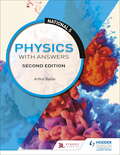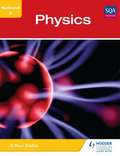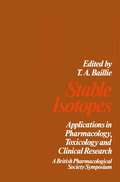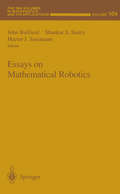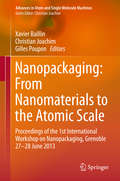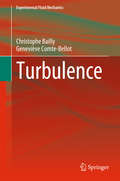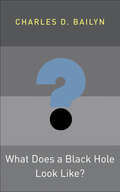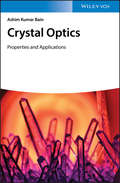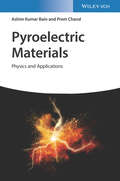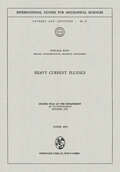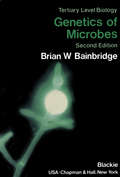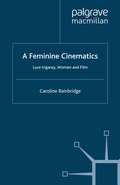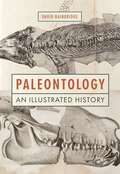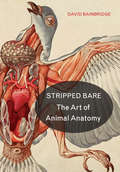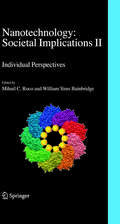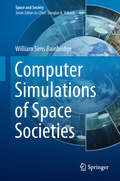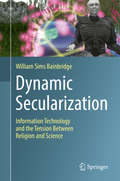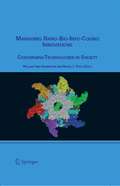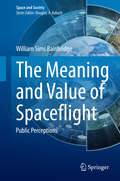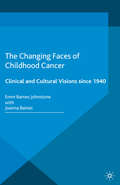- Table View
- List View
National 5 Physics with Answers: Second Edition Epub
by Arthur BaillieExam Board: SQALevel: National 5Subject: PhysicsFirst Teaching: September 2017First Exam Summer 2018This second edition has been comprehensively updated to reflect the changes made by the SQA to the National 5 Course Specification with chapters on the following areas of physics: Electricity, Properties of matter, Waves, Radiation, Dynamics, and Space.- Covers the new specification with all the new topics in the SQA examinations- Provides thorough exam preparation, with practice exercises- Organised to make it easy to plan, manage and monitor student progress
SQA National 5 Physics (PDF)
by Arthur BaillieA full course textbook for the new National 5 Physics syllabus, endorsed by SQA! This book is designed to act as a valuable resource for pupils studying National 5 Physics. It provides a core text which adheres closely to the SQA syllabus, with each section of the book matching a unit of the syllabus, and each chapter corresponding to a content area. It is an ideal and comprehensive teaching and learning resource for National 5 Physics.
Essays on Mathematical Robotics: (pdf) (The IMA Volumes in Mathematics and its Applications #104)
by John Baillieul Shankar S. Sastry Hector J. SussmannNanopackaging: Proceedings of the 1st International Workshop on Nanopackaging, Grenoble 27-28 June 2013 (Advances in Atom and Single Molecule Machines)
by Xavier Baillin Christian Joachim Gilles PouponThis book is a first attempt to merge two different communities: scientists and technologists. Therefore, it is not a general overview covering all the fields of nanopackaging, but is mainly focused on two topics. The first topic deals with atomic scale devices or circuit requirements, as well as related recent technological developments; for example, surface science engineering and atomic scale interconnects studies. The second main part of the book brings CNT nano-materials solutions for resolving interconnect or thermal management problems in microelectronics device packaging. This book is not just useful for those who attended the International Workshop on Nanopackaging in Grenoble, but can provide valuable information to scientists and technologists in the nanopackaging community.
Turbulence (Experimental Fluid Mechanics)
by Christophe Bailly Geneviève Comte-BellotThis book covers the major problems of turbulence and turbulent processes, including physical phenomena, their modeling and their simulation.After a general introduction in Chapter 1 illustrating many aspects dealing with turbulent flows, averaged equations and kinetic energy budgets are provided in Chapter 2. The concept of turbulent viscosity as a closure of the Reynolds stress is also introduced. Wall-bounded flows are presented in Chapter 3 and aspects specific to boundary layers and channel or pipe flows are also pointed out. Free shear flows, namely free jets and wakes, are considered in Chapter 4. Chapter 5 deals with vortex dynamics. Homogeneous turbulence, isotropy and dynamics of isotropic turbulence are presented in Chapters 6 and 7. Turbulence is then described both in the physical space and in the wave number space. Time dependent numerical simulations are presented in Chapter 8, where an introduction to large eddy simulation is offered. The last three chapters of the book summarize remarkable digital techniques current and experimental. Many results are presented in a practical way, based on both experiments and numerical simulations.The book is written for a advanced engineering students as well as postgraduate engineers and researchers. For students, it contains the essential results as well as details and demonstrations whose oral transmission is often tedious. At a more advanced level, the text provides numerous references which allow readers to find quickly further study regarding their work and to acquire a deeper knowledge on topics of interest.
What Does a Black Hole Look Like?
by Charles D. BailynEmitting no radiation or any other kind of information, black holes mark the edge of the universe--both physically and in our scientific understanding. Yet astronomers have found clear evidence for the existence of black holes, employing the same tools and techniques used to explore other celestial objects. In this sophisticated introduction, leading astronomer Charles Bailyn goes behind the theory and physics of black holes to describe how astronomers are observing these enigmatic objects and developing a remarkably detailed picture of what they look like and how they interact with their surroundings.Accessible to undergraduates and others with some knowledge of introductory college-level physics, this book presents the techniques used to identify and measure the mass and spin of celestial black holes. These key measurements demonstrate the existence of two kinds of black holes, those with masses a few times that of a typical star, and those with masses comparable to whole galaxies--supermassive black holes. The book provides a detailed account of the nature, formation, and growth of both kinds of black holes. The book also describes the possibility of observing theoretically predicted phenomena such as gravitational waves, wormholes, and Hawking radiation.A cutting-edge introduction to a subject that was once on the border between physics and science fiction, this book shows how black holes are becoming routine objects of empirical scientific study.
What Does a Black Hole Look Like?
by Charles D. BailynEmitting no radiation or any other kind of information, black holes mark the edge of the universe--both physically and in our scientific understanding. Yet astronomers have found clear evidence for the existence of black holes, employing the same tools and techniques used to explore other celestial objects. In this sophisticated introduction, leading astronomer Charles Bailyn goes behind the theory and physics of black holes to describe how astronomers are observing these enigmatic objects and developing a remarkably detailed picture of what they look like and how they interact with their surroundings.Accessible to undergraduates and others with some knowledge of introductory college-level physics, this book presents the techniques used to identify and measure the mass and spin of celestial black holes. These key measurements demonstrate the existence of two kinds of black holes, those with masses a few times that of a typical star, and those with masses comparable to whole galaxies--supermassive black holes. The book provides a detailed account of the nature, formation, and growth of both kinds of black holes. The book also describes the possibility of observing theoretically predicted phenomena such as gravitational waves, wormholes, and Hawking radiation.A cutting-edge introduction to a subject that was once on the border between physics and science fiction, this book shows how black holes are becoming routine objects of empirical scientific study.
Crystal Optics: Properties and Applications
by Ashim Kumar BainReviews the properties and applications of photo-elastic, acousto-optic, magneto-optic, electro-optic, and photorefractive materials This book deals with the basic physical properties and applications of photo-elastic, acousto-optic, magneto-optic, electro-optic, and photorefractive materials. It also provides up-to-date information on the design and applications of various optoelectronic devices based on these materials. The first chapter of Crystal Optics: Properties and Applications covers the basic concepts of crystal optics, such as index ellipsoid or optical indicatrix, crystal symmetry, wave surface, birefringence, and the polarization of light. Chapter 2 reviews the physical phenomena of crystal optics in isotropic and crystalline materials. It describes in detail research information on modern photoelastic materials and reviews the up-to-date photoelastic device applications. Chapter 3 develops the underlying theory of acousto-optics from first principles, formulating results suitable for subsequent calculations and design. The fourth chapter describes the basic principles of magneto-optic effects and mode of interaction with magnetic materials. The fifth chapter provides an understanding of the physical phenomenon of the linear and quadratic electro-optic effects in isotropic and crystalline materials. The last chapter collects many of the most important recent developments in photorefractive effects and materials, and pays special attention to recent scientific findings and advances on photorefractive materials and devices. -Features up to date information on the design and applications of various optoelectronic devices -Looks at the basic concepts of crystal optics, including the polarization of light, effects of reflection and transmission of polarization and light polarizing devices, and more -Pays special attention to design procedures for the entire range of acousto-optic devices and various applications of these devices -Provides research information on modern magneto-optic materials and reviews the up-to-date magneto-optic device applications?up to terahertz (THz) regime Crystal Optics: Properties and Applications is an excellent book for the scientific community working in the field, including researchers, lecturers, and advanced students.
Crystal Optics: Properties and Applications
by Ashim Kumar BainReviews the properties and applications of photo-elastic, acousto-optic, magneto-optic, electro-optic, and photorefractive materials This book deals with the basic physical properties and applications of photo-elastic, acousto-optic, magneto-optic, electro-optic, and photorefractive materials. It also provides up-to-date information on the design and applications of various optoelectronic devices based on these materials. The first chapter of Crystal Optics: Properties and Applications covers the basic concepts of crystal optics, such as index ellipsoid or optical indicatrix, crystal symmetry, wave surface, birefringence, and the polarization of light. Chapter 2 reviews the physical phenomena of crystal optics in isotropic and crystalline materials. It describes in detail research information on modern photoelastic materials and reviews the up-to-date photoelastic device applications. Chapter 3 develops the underlying theory of acousto-optics from first principles, formulating results suitable for subsequent calculations and design. The fourth chapter describes the basic principles of magneto-optic effects and mode of interaction with magnetic materials. The fifth chapter provides an understanding of the physical phenomenon of the linear and quadratic electro-optic effects in isotropic and crystalline materials. The last chapter collects many of the most important recent developments in photorefractive effects and materials, and pays special attention to recent scientific findings and advances on photorefractive materials and devices. -Features up to date information on the design and applications of various optoelectronic devices -Looks at the basic concepts of crystal optics, including the polarization of light, effects of reflection and transmission of polarization and light polarizing devices, and more -Pays special attention to design procedures for the entire range of acousto-optic devices and various applications of these devices -Provides research information on modern magneto-optic materials and reviews the up-to-date magneto-optic device applications?up to terahertz (THz) regime Crystal Optics: Properties and Applications is an excellent book for the scientific community working in the field, including researchers, lecturers, and advanced students.
Pyroelectric Materials: Physics and Applications
by Ashim Kumar Bain Prem ChandPyroelectric Materials An authoritative and practical discussion of pyroelectric materials and their applications In Pyroelectric Materials: Physics and Applications, the authors deliver a comprehensive exploration of the physics of pyroelectric materials and their applications. With authoritative coverage of a wide variety of critical topics in the field, the authors provide the readers with chapters on dielectric fundamentals, pyroelectricity, pyroelectric materials and their applications such as pyroelectric infrared detectors, pyroelectric energy harvesting, and pyroelectric fusion. Readers will also find: A thorough introduction to the fundamentals of dielectrics, including discussions of polarization, dispersion, relaxation, and the molecular theory of induced charges in a dielectric Comprehensive explorations of pyroelectricity, including its history, theory, and a simple model of pyroelectric effect Perfect for researchers and professionals with an interest in pyroelectric materials, the book is also useful for graduate students taking courses involving pyroelectric materials and their applications.
Pyroelectric Materials: Physics and Applications
by Ashim Kumar Bain Prem ChandPyroelectric Materials An authoritative and practical discussion of pyroelectric materials and their applications In Pyroelectric Materials: Physics and Applications, the authors deliver a comprehensive exploration of the physics of pyroelectric materials and their applications. With authoritative coverage of a wide variety of critical topics in the field, the authors provide the readers with chapters on dielectric fundamentals, pyroelectricity, pyroelectric materials and their applications such as pyroelectric infrared detectors, pyroelectric energy harvesting, and pyroelectric fusion. Readers will also find: A thorough introduction to the fundamentals of dielectrics, including discussions of polarization, dispersion, relaxation, and the molecular theory of induced charges in a dielectric Comprehensive explorations of pyroelectricity, including its history, theory, and a simple model of pyroelectric effect Perfect for researchers and professionals with an interest in pyroelectric materials, the book is also useful for graduate students taking courses involving pyroelectric materials and their applications.
Heavy Current Fluidics: Course held at the Department of Fluiddynamics, October 1970 (CISM International Centre for Mechanical Sciences #45)
by Donald BainGenetics of Microbes (Tertiary Level Biology)
by Brian W. BainbridgeWriting a textbook on microbial genetics in about 200 pages was un doubtedly a difficult task, but I have been encouraged by the response from both students and lecturers to the first edition. The requirement for a second edition is also a measure of the need for such a book. My experience as a lecturer has shown that what is needed first is an intelligible framework which can be read in a reasonable period of time. Armed with these principles, a student can then go to reviews and the original literature with a reasonable chance of understanding the jargon and the details. Molecular genetics is now so well advanced that it is easy to lose track of the purpose of a set of experiments in the wealth of sequence data and complex interactions. I have therefore kept the same format for this edition with a well-illustrated text giving original papers, popular reviews, monographs and detailed reviews to enable the student to take the subject further as required.
A Feminine Cinematics: Luce Irigaray, Women and Film
by Caroline BainbridgeThis timely book provides new insights into debates around the relationship between women and film by drawing on the work of philosopher Luce Irigaray. Arguing that female-directed cinema provides new ways to explore ideas of representation and spectatorship, it also examines the importance of contexts of production, direction and reception.
Paleontology: An Illustrated History
by David BainbridgeAn illustrated look at the art and science of paleontology from its origins to todayHumans have been stumbling upon the petrified remains of ancient animals since prehistoric times, leading to tales of giant dogs, deadly dragons, tree gods, sea serpents, and all manner of strange and marvelous creatures. In this richly illustrated book, David Bainbridge recounts how legends like these gradually gave rise to the modern science of paleontology, and how this pioneering discipline has reshaped our view of the natural world.Bainbridge takes readers from ancient Greece to the eighteenth century, when paleontology began to coalesce into the scientific field we know today, and discusses how contemporary paleontologists use cutting-edge technologies to flesh out the discoveries of past and present. He brings to life the stories and people behind some of the greatest fossil finds of all time, and explains how paleontology has long straddled the spheres of science and art. Bainbridge also looks to the future of the discipline, discussing how the rapid recovery of DNA and other genetic material from the fossil record promises to revolutionize our understanding of the origins and evolution of ancient life.This panoramic book brings together stunning illustrations ranging from early sketches and engravings to eye-popping paleoart and high-tech computer reconstructions.
Paleontology: An Illustrated History
by David BainbridgeAn illustrated look at the art and science of paleontology from its origins to todayHumans have been stumbling upon the petrified remains of ancient animals since prehistoric times, leading to tales of giant dogs, deadly dragons, tree gods, sea serpents, and all manner of strange and marvelous creatures. In this richly illustrated book, David Bainbridge recounts how legends like these gradually gave rise to the modern science of paleontology, and how this pioneering discipline has reshaped our view of the natural world.Bainbridge takes readers from ancient Greece to the eighteenth century, when paleontology began to coalesce into the scientific field we know today, and discusses how contemporary paleontologists use cutting-edge technologies to flesh out the discoveries of past and present. He brings to life the stories and people behind some of the greatest fossil finds of all time, and explains how paleontology has long straddled the spheres of science and art. Bainbridge also looks to the future of the discipline, discussing how the rapid recovery of DNA and other genetic material from the fossil record promises to revolutionize our understanding of the origins and evolution of ancient life.This panoramic book brings together stunning illustrations ranging from early sketches and engravings to eye-popping paleoart and high-tech computer reconstructions.
Stripped Bare: The Art of Animal Anatomy
by David BainbridgeA lavishly illustrated compendium of the art and history of animal anatomy from antiquity to todayFor more than two thousand years, comparative anatomy—the study of anatomical variation among different animal species—has been used to make arguments in natural philosophy, reinforce religious dogma, and remind us of our own mortality. This stunningly illustrated compendium traces the intertwined intellectual and artistic histories of comparative anatomy from antiquity to today.Stripped Bare brings together some of the most arresting images ever produced, from the earliest studies of animal form to the technicolor art of computer-generated anatomies. David Bainbridge draws on representative illustrations from different eras to discuss the philosophical, scientific, and artistic milieus from which they emerged. He vividly describes the unique aesthetics of each phase of anatomical endeavor, providing new insights into the exquisite anatomical drawings of Leonardo and Albrecht Dürer in the era before printing, Jean Héroard’s cutting and cataloging of the horse during the age of Louis XIII, the exotic pictorial menageries of the Comte de Buffon in the eighteenth century, anatomical illustrations from Charles Darwin’s voyages, the lavish symmetries of Ernst Haeckel’s prints, and much, much more.Featuring a wealth of breathtaking color illustrations throughout, Stripped Bare is a panoramic tour of the intricacies of vertebrate life as well as an expansive history of the peculiar and beautiful ways humans have attempted to study and understand the natural world.
The X in Sex: How the X Chromosome Controls Our Lives
by David BainbridgeA tiny scrap of genetic information determines our sex; it also consigns many of us to a life of disease, directs or disrupts the everyday working of our bodies, and forces women to live as genetic chimeras. The culprit--so necessary and yet the source of such upheaval--is the X chromosome, and this is its story. An enlightening and entertaining tour of the cultural and natural history of this intriguing member of the genome, The X in Sex traces the journey toward our current understanding of the nature of X. From its chance discovery in the nineteenth century to the promise and implications of ongoing research, David Bainbridge shows how the X evolved and where it and its counterpart Y are going, how it helps assign developing human babies their sex--and maybe even their sexuality--and how it affects our lives in infinitely complex and subtle ways. X offers cures for disease, challenges our cultural, ethical, and scientific assumptions about maleness and femaleness, and has even reshaped our views of human evolution and human nature.
Nanotechnology: I: Maximising Benefits for Humanity; II: Individual Perspectives
by William S. BainbridgeAdvances in nanoscience and nanotechnology promise great technical breakthroughs in the coming decades. In this book, leading scientists, engineers, and social scientists review the possible uses of these impending technical developments in various industrial, medical, and national security applications. They also examine the corresponding ethical, legal, social, economic, and educational issues that these developments raise.
Computer Simulations of Space Societies (Space and Society)
by William Sims BainbridgeAt the intersection of astronautics, computer science, and social science, this book introduces the challenges and insights associated with computer simulation of human society in outer space, and of the dynamics of terrestrial enthusiasm for space exploration. Never before have so many dynamic representations of space-related social systems existed, some deeply analyzing the logical implications of social-scientific theories, and others open for experience by the general public as computer-generated virtual worlds. Fascinating software ranges from multi-agent artificial intelligence models of civilization, to space-oriented massively multiplayer online games, to educational programs suitable for schools or even for the world's space exploration agencies. At the present time, when actual forays by humans into space are scarce, computer simulations of space societies are an excellent way to prepare for a renaissance of exploration beyond the bounds of Earth.
Dynamic Secularization: Information Technology and the Tension Between Religion and Science
by William Sims BainbridgeThis book discusses secularization, arguing that it may be more complex and significant than is generally recognized. Using a number of online exploration methods, the author provides insights into how religion may be changing, and how information technology might be energized in this process.Working from the premise that the relationship between science and religion is complex, the author demonstrates that while science has contradicted some specific religious beliefs, science itself may have been facilitated by beliefs formed many centuries ago. Science assists engineers in the development of powerful new technologies, and asserts that the universe is based on a set of fundamental principles that can be understood by humans through the assistance of mathematics. The challenging ideas discussed will benefit readers through sharing a variety of Internet-based research methods and cultural discoveries. The book provides a balance between quantitative methods, illustrated by 24 tables of statistics, and qualitative methods, illustrated by 30 screenshots of computer-generated virtual worlds. Analysis interweaves with description, creating a sense of involvement in the experience of exploring online realities at the same time as radical insights are shared.
Managing Nano-Bio-Info-Cogno Innovations: Converging Technologies in Society
by William Sims BainbridgeWith the convergence of Nanotechnology, Biotechnology, Information technology and Cognitive science (NBIC) fields promising to change our competitive, operational, and employment landscape in fundamental ways, we find ourselves on the brink of a new technological and science-driven business revolution. The already emerging reality of convergence is to be found in genomics, robotics, bio-information and artificial intelligence applications, such as: • Self-assembled, self-cleaning and self-healing manufactured materials and textiles, and much stronger, lighter and more customizable structural materials, • Miniature sensors allowing unobtrusive real-time health monitoring and dramatically improved diagnosis; with greatly enhanced real time information to vehicles and drivers on the way, • New generations of supercomputers and efficient energy generators based on biological processes, • Greatly enhanced drug delivery from unprecedented control over fundamental structural properties and biocompatibility of materials. These advances are here already, or in development. And Japan, other Asian nations and Western European countries are investing heavily and moving aggressively to develop and apply NBIC technologies. Notwithstanding the passage of the 21st Century Nanotechnology Research and Development Act, significant further funding and action by both government and private industry will be critical to maintaining US scientific and industry leadership.
The Meaning and Value of Spaceflight: Public Perceptions (Space and Society)
by William Sims BainbridgeThis book presents the most serious and comprehensive study, by far, of American public perceptions about the meaning of space exploration, analyzing vast troves of questionnaire data collected by many researchers and polling firms over a span of six decades and anchored in influential social science theories. It doesn't simply report the percentages who held various opinions, but employs sophisticated statistical techniques to answer profound questions and achieve fresh discoveries.Both the Bush and the Obama administrations have cut back severely on fundamental research in space science and engineering. Understanding better what space exploration means for citizens can contribute to charting a feasible but progressive course. Since the end of the Space Race between the US and the USSR, social scientists have almost completely ignored space exploration as a topic for serious analysis and this book seeks to revive that kind of contribution.The author communicates the insights in a lucid style, not only intelligible but interesting to readers from a variety of backgrounds.
The Changing Faces of Childhood Cancer: Clinical and Cultural Visions since 1940 (Science, Technology and Medicine in Modern History)
by Joanna Baines Emm Barnes JohnstoneThis book traces the development of British answers to the problem of childhood cancer. The establishment of the NHS and better training for paediatricians, meant children were given access to experimental chemotherapy, sending cure rates soaring. Children with cancer were thrust into the spotlight as individuals' stories of hope hit the headlines.
